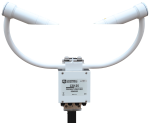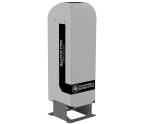
| Services Available |
|---|
Resumen
El PWS100 es un sensor basado en láser que mide la precipitación y visibilidad determinando de forma precisa el tamaño y velocidad de las gotas de agua en el aire. Puede utilizarse en estaciones meteorológicas para carreteras y aeropuertos. El PWS100 usa técnicas de medida avanzadas y algoritmos que calculan de forma individual el tipo de partícula de precipitación.
En aplicaciones aeronáuticas el PSW100 cumple con las recomendaciones CAA e ICAO y cumple o excede todas las recomendaciones y especificaciones CAP437, CAP670 y CAP746.
Leer másVentajas y características
- Unique calibration kit available to calibrate particle size and speed measurement to give confidence in reliable measurement of present weather parameters.
- Identifica 9 tipos básicos de precipitación, incluyendo llovizna, lluvia, nieve, granizo y granizo blando
- Sistema patentado de cuatro haces y dos receptores que mide directamente el tamaño de los hidrometeoros y velocidad
- Reporta visibilidad MOR rango 0 a 20.000m con alarma programable
Imágenes

Descripción detallada
El sensor de tiempo presente PWS100 es un sensor basado en láser capaz de determinar precipitación y visibilidad, que es utilizado habitualmente en estaciones meteorológicas automáticas para carreteras, aplicaciones marinas y en aeropuertos. Su avanzada técnica de medida y sofisticados algoritmos, le permite determinar el tipo de partícula de precipitación a partir de precisas medidas del tamaño y velocidad de las partículas, y de la estructura de la señal recibida. Con medidas auxiliares de temperatura y humedad relativa, se puede clasificar mejor el tipo de partícula.
El PWS100 lo forman la unidad Digital Signal Processor (DSP) que va conectada a un brazo del sensor que contiene el cabezal láser y a dos cabezales sensor. Cada cabezal sensor está 20° desfasado del eje de la unidad láser—uno en el plano horizontal y el otro en el plano vertical. El PWS100 se entrega con anclajes de montaje que permiten fijar la unidad DSP a un poste o mástil.
En el siguiente enlace aquí puede descargarse un potente programa ejemplo documentado y que incluye configuración avanzada, CRC checks, etc.
Preguntas frecuentes
Número de FAQs relacionadas con PWS100: 7
Expandir todoDesplegar todo
-
The Present Weather Viewer is available for download from the Downloads section of the PWS100 product page.
-
Yes. For in-situ calibration by the user, use the PWC100 (Calibrator for PWS100). There is a separate PWC100 instruction manual.
-
The PWS100 measures visibility by the amount of light that scatters off the particles in the sensing volume, and thus, it cannot measure visibility reduction because of absorption. However, because reduction of visibility by airborne particles is dominated by the scattering effect, the PWS100 is able to measure reduced visibility because of sand, dust, and smoke. The value, however, is less accurate and reads slightly higher for blowing dust, sand, or smoke than for precipitation.
-
The basic processing current of the PWS100 is <200 mA at 12 V supply. However, the sensor has two levels of heating available. One set of heaters—known as the dew heaters—prevents condensation on the main lenses of the sensor. When these sensors turn on, the current usage increases to approximately 500 mA at 12 V. A current drain of 1 A is the worst case scenario if the input supply to the sensor drops to the minimum of approximately 9 V (the current drain increasing at lower voltages).
By default, the dew heaters turn on all the time and the main hood heaters are off. The dew heaters can be turned off by the user.
The main hood heaters run from a separate power supply and consume 7 A at 24 V when fully on. The main hood heaters only need to be used when icing conditions are likely.
-
The PWS100 measures the size and velocity of particles in the air. It can provide precipitation rate and water equivalent accumulation, but it is primarily used to report present weather codes, as defined by the World Meteorological Organization and National Weather Service, and particle size and velocity distributions. The PWS100 cannot measure snow depth, as it identifies water droplets in air.
-
The Present Weather Viewer does not have a save function for the data. The software is designed as a tool to view current data coming from the fields included in the default message of the PWS100. The Present Weather Viewer can also be used to configure the sensor and access the built-in menu system.
To read, store, and collect data, connect the PWS100 to one of the dataloggers or query the sensor directly.
-
Unless the rain gage is poorly sited, the PWS100, similar to most sensors of this type, is less accurate measuring precipitation accumulation than a conventional rain gage.
The PWS100, because of its high sensitivity, is more accurate at detecting the start, end, and totals of very fine rainfall events. In addition, the PWS100 does not experience the evaporation issues that a rain gage does.
Compatibilidad
Nota: lo siguiente muestra información de compatibilidad notable. No es una lista de todos los productos compatibles.
Dataloggers
| Producto | Compatible | Nota |
|---|---|---|
| 21X (retired) | ||
| CR10 (retired) | ||
| CR1000 (retired) | ||
| CR10X (retired) | ||
| CR200X (retired) | ||
| CR216X (retired) | ||
| CR23X (retired) | ||
| CR300 (retired) | ||
| CR3000 (retired) | ||
| CR310 | ||
| CR500 (retired) | ||
| CR5000 (retired) | ||
| CR510 (retired) | ||
| CR6 | ||
| CR800 (retired) | ||
| CR850 (retired) | ||
| CR9000 (retired) | ||
| CR9000X (retired) |
Especificaciones
| Measuring Area | 40 cm2 per light sheet |
| IP Rating | IP 66 (NEMA 4X) |
| Housing Material | Iridite NCP conversion coated aluminium (RoHS compliant) and hard anodized aluminum |
| Communication | RS-232, RS-422, or RS-485 |
| Baud Rate | Selectable from 300 bps to 115.2 kbps |
| Control Unit | Custom DSP Board |
| EMC Compliance | Tested and conforms to BS EN61326:1998 |
| Dimensions | 115 x 70 x 40 cm (45.28 x 27.56 x 15.75 in.) |
| Weight | 8 kg (17.6 lb) |
Power Requirements |
|
| DSP Power | 9 to 24 Vdc (or 9 to 16 Vdc with CS215-PWS Temperature and RH sensor) |
| Current Consumption | 200 mA to 1 A |
| Hood Heater | 24 Vac or dc, 7 A |
Optical |
|
| Laser Source | Near-infrared diode, eye safe Class 1M unit output |
| Peak Wavelength | 830 nm |
| Modulation Frequency | 96 kHz |
| Receivers | Photodiode with band pass filters |
| Spectral Response | Maximum spectral sensitivity at 850 nm, 0.62 A/W (0.6 A/W at 830 nm) |
| Lens Check Light Source | Near-infrared LED |
Measurement |
|
| Particle Size | 0.1 to 30 mm (0.0039 to 1.18 in.) |
| Size Accuracy | ±5% (for particles greater than 0.3 mm [0.0118 in.]) |
| Particle Velocity | 0.16 to 30 m/s |
| Velocity Accuracy | ±5% (for particles > 0.3 mm [0.012 in.]) |
| Types of Precipitation Detected | Drizzle, rain, snow grains, snowflakes, hail, ice pellets, graupel, mixed (combination of types above) |
| Rain Rate Intensity Range | 0 to 999.9 mm/h-1 |
| Rainfall Resolution | 0.0001 mm |
| Rain Total Accuracy |
Typically ±10% Accuracy figures are for laboratory conditions with reference particles and standards; accuracy will be degraded for windy conditions, frozen precipitation, and very high rainfall rates. |
| Visibility Range | 0 to 20,000 m (0 to 65,616.8 ft) |
| Visibility Accuracy | ±10% to 10,000 m (±10% to 32,808.4 ft) |
| Visibility Measurement Interval | User-selectable from 10 s to 2 h |
| External Sensors | SDI-12 compatible sensors supported (such as the CS215-PWS Temperature and RH Probe) |
| Detection Threshold | > 0.02 mm hr-1 |
| Accumulation Accuracy | ±10% |
Documentos
Folletos producto
Casos de aplicación
Descargas
PWS100 Present Weather Viewing Software v.2.6.1 (32 MB) 24-01-2012
Designed to complement the PWS100 the Present Weather Viewer provides a simple yet comprehensive interface showcasing many of the capabilities of the PWS100 whilst providing easy configuration of key sensor features.
PWS100 Sample program (24 kb) 05-04-2016
A powerful, documented sample program for the PWS100 that includes advanced setup, CRC checks, etc.,
Casos de aplicación
The Channel Tunnel (or Chunnel) connects the United Kingdom with France. It is actually a......leer más



